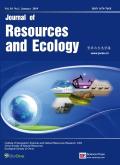Vulnerability and Influencing Factors for Rural Settlements Land Use in Karst Mountains of China: Case Study on Qixingguan District
Q3 Environmental Science
引用次数: 1
Abstract
Abstract: Studying the vulnerability of rural settlements is necessary for their revitalization and sustainable development. In this study, a basic organizational framework and evaluation system that considers the natural environment, social development, and other factors in terms of exposure, sensitivity, and adaptability were developed for the vulnerability of rural settlements. Qixingguan District of Bijie City was considered as a case study, and a geographic information system spatial analysis function and geographic probe model were applied to determine the spatial distribution and characteristics of rural settlement vulnerability in karst mountains and their influencing factors. The results demonstrated that rural settlements here have a multicore distribution pattern where the vulnerability is moderately low overall but has significant spatial heterogeneity. There is a considerable positive spatial correlation between vulnerable rural settlements and weakly negative correlations between exposure and adaptability and between sensitivity and adaptability, which can be attributed to the interaction among natural, human-made, and social factors. The primary factors influencing the vulnerability of rural settlements here are stone desertification and soil erosion. These results have important theoretical and practical value for enhancing the stability of rural human-land systems in karst mountains and their long-term protection.中国喀斯特山区农村居民点土地利用的脆弱性和影响因素:七星关区案例研究
摘要:研究农村居民点的脆弱性对其振兴和可持续发展十分必要。本研究从暴露度、敏感度、适应度等方面,综合考虑自然环境、社会发展等因素,建立了农村居民点脆弱性的基本组织框架和评价体系。以毕节市七星关区为例,应用地理信息系统的空间分析功能和地理探测模型,确定了岩溶山区农村居民点脆弱性的空间分布、特征及其影响因素。结果表明,这里的农村居民点呈多核分布格局,脆弱性总体上中等偏低,但具有明显的空间异质性。脆弱的农村居民点之间存在相当大的空间正相关性,暴露与适应性之间以及敏感性与适应性之间存在弱的负相关,这可能归因于自然、人为和社会因素之间的相互作用。在这里,影响农村居民点脆弱性的主要因素是石漠化和水土流失。这些结果对于提高岩溶山区农村人地系统的稳定性及其长期保护具有重要的理论和实践价值。
本文章由计算机程序翻译,如有差异,请以英文原文为准。
求助全文
约1分钟内获得全文
求助全文
来源期刊

Journal of Resources and Ecology
Environmental Science-Ecology
CiteScore
2.40
自引率
0.00%
发文量
107
 求助内容:
求助内容: 应助结果提醒方式:
应助结果提醒方式:


